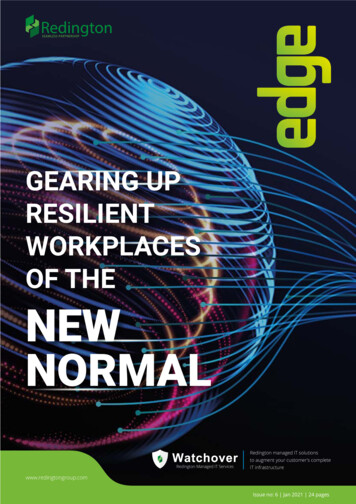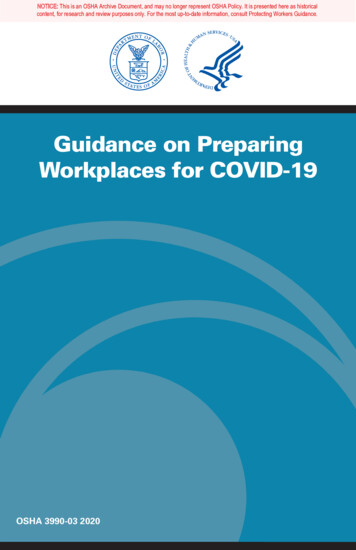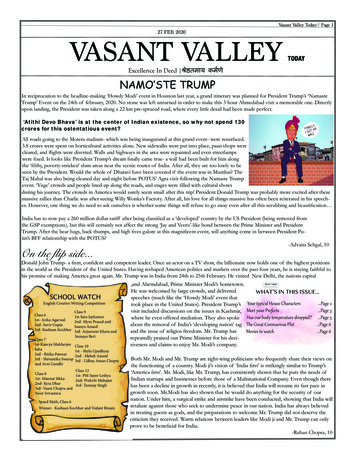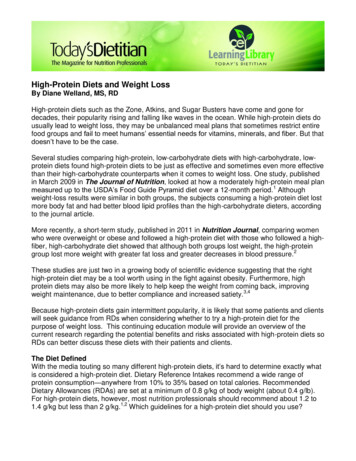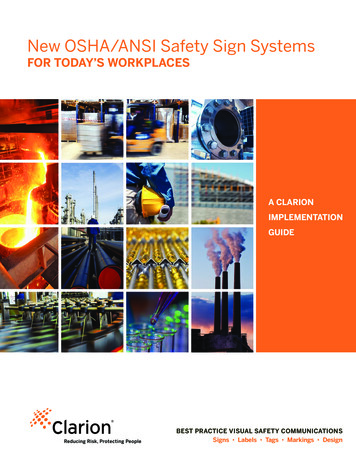
Transcription
New OSHA/ANSI Safety Sign SystemsFOR TODAY’S WORKPLACESA CLARIONIMPLEMENTATIONGUIDEBEST PRACTICE VISUAL SAFETY COMMUNICATIONSSigns Labels Tags Markings Design
IntroductionThe Role of Safety SignsTable of ContentsEnvironmental, health and safety professionals know thatit’s critical to effectively communicate safety. Safety signs,labels, tags and markings play a key role in achieving thisobjective; they are the visual tools you use to:Introduction. p.2 Remind people of potential hazards and how toavoid themThe New OSHA/ANSI Sign Explained. p.3Why Use the New OSHA-Approved Formats?. p.4The Evolution of Sign Technology. p.6 Point people to the location of emergency equipmentHazard Alerting Signs & Tags.p.6 Direct people’s path to safety in an emergency situationSecurity & General Policy Safety Signs.p.7 Reinforce safety training programsSafety Instruction & Equipment Location Signs.p.8 Inform people of security and limited access policiesYour safety sign system is a direct reflection of yourcompany’s safety culture. Taken together, your signsystem visually demonstrates your care and concern forthe health and safety of your employees, guests, visitors,subcontractors and temporary workers.Fire Equipment Location Signs.p.9Egress Pathmarking Signs.p.10Building Your New Sign System. p.11Step 1: Assess What You Have.p.11Step 2: How To Select the Right Signs.p.12The Goal: Zero Fatalities, Zero InjuriesStep 3: Choose the Right Location, Size and Style.p.140Step 4: Choose the Right Materials.p.15References. p.16About Clarion. p.17The Purpose of This GuideIn the fall of 2013, theReducingOccupationalSafety and HealthRisk, Protecting PeopleAdministration (OSHA) endorsed the latest best practicesrelated to safety sign and tag technology by incorporatingthe 2011 ANSI Z535 safety sign and tag standards into itsregulations. This guide will: Provide a clear understanding of the OSHA change andwhat it means to you and your organization Define the key steps to implement a new, OSHA/ANSIbest practice safety sign system to better reduce risk andprotect people from harmClarion Safety Systems · (800) 748-0241 · ClarionSafety.com · info@clarionsafety.com 2013 Clarion Safety Systems. All rights reserved.2
Bale strappingcan injure.The New OSHA/ANSI SignExplainedWear face shieldswhen cuttingor handlingbale strapping.The new OSHA/ANSI sign and tag formats use nationally and internationallystandardized elements to better convey safety messages in today’s workplace.The New Components:Safety Alert SymbolIndicates a potential personal injury hazard exists. It is only used on DANGER,WARNING and CAUTION signs, labels and tags.Signal Words for Hazard Alerting Safety MessagesDANGER indicates a hazardous situation which, if not avoided, will resultin serious injury or death. Its use should be limited to the most extremesituations.WARNING indicates a hazardous situation which, if not avoided, could resultin serious injury or death.CAUTION indicates a hazardous situation which, if not avoided, could result inminor or moderate injury.Signal Words for Non-Hazard Alerting Safety MessagesNOTICE indicates information considered important but not directly hazardrelated (e.g. security, hygiene, equipment or property damage).NOTICESignal Words for Instructional Safety MessagesSAFETY INSTRUCTIONS is the signal word used to provide explanatoryinformation like procedures and instructions. More definitive words can beReducingRisk,Protectingused in this signal wordpanel (e.g.SAFEBOILERPeopleSHUTDOWN PROCEDURE,LOCKOUT PROCEDURE).SAFETYINSTRUCTIONSSymbolsGraphical symbols are used to bridge language barriers and draw attentionto the safety message. Specific shape, color and design principles are used tomeet global compliance objectives.Text MessagesCarefully crafted text is used to convey the safety message to the intendedaudience in a clear, concise manner.Clarion Safety Systems · (800) 748-0241 · ClarionSafety.com · info@clarionsafety.com 2013 Clarion Safety Systems. All rights reserved.3
Why Use the New OSHA-Approved Formats?REASON 1: TO BETTER PROTECT PEOPLE FROM HARMThe first reason to adopt the new OSHA/ANSI sign system isthat it more effectively communicates safety by: Using globally communicative symbols to overcomelanguage barriers, drawing attention to the sign, making itstand out from all of the other posted signage people seeon a daily basis Containing more substantive content that explains hazardsand how to avoid themBy visually reinforcing safety training and bettercommunicating safety to guests, subcontractors andtemporary workers, the OSHA/ANSI signs are aimed at helpingachieve fewer workplace accidents and injuries.The new OSHA/ANSI signs and tags reflect the high valueOSHA is placing on global sign standardization initiatives likeGHS for hazardous chemical labeling. The new ANSI safetysign technology does the same thing GHS does, which, inOSHA’s words, is to give people more than just the right toknow about a hazard; they fulfill the right people have tounderstand a hazard and how to properly avoid it.OSHA’s new 2013 signregulations are here —and they’re ready for immediateimplementation. Learn about howClarion’s safety signs, tags andmarkings help companies protectpeople and better meet today’sever-increasing regulatory andliability climate.Reducing Risk, Protecting PeopleClarion Safety Systems · (800) 748-0241 · ClarionSafety.com · info@clarionsafety.com 2013 Clarion Safety Systems. All rights reserved.Visitclarionsafety.com/NewOSHA4
Why Use the New OSHA-Approved Formats?REASON 2: TO BETTER PROTECT YOUR COMPANY FROM LITIGATIONThe second reason to adopt the OSHA/ANSI formats isthat they represent the “state-of-the-art” for visual safetycommunication technology. Properly using them will provideyour company with a better defense in court should anaccident occur and a lawsuit arise. Unlike the older sign andtag formats, the new formats are based on design principlesderived from:EXITEmergencyShower U.S. case law concerning the legal criteria for the content of“adequate warnings” Human factors research on what makes a safety signeffective and what information needs to be conveyed tobetter motivate people to obey safety messages Current standards-based risk assessment methods thatuse carefully defined, severity-ranked, color-coded signalwords on safety signs and tagsFor the time being, OSHA is allowing continued use ofthe older, out-of-date formats. But organizations need tounderstand this: legal theories attached to premises liabilityare creating the “duty to warn” in public areas and workplaces,especially when subcontractors, temporary workers, andguests are increasingly found in today’s more diverse workenvironments. If an accident occurs and a non-employedperson is injured, the risk of litigation is high. The new OSHA/ANSI safety sign systems will help your organization to meetthis new standard of care to provide “adequate warnings.” 1Reducing Risk, Protecting PeopleFIRSTAIDBurnhazard.Hot surfaces.FireExtinguisherDo NOT touch.EYEWASHFIREALARMFirst AidStationTHINKSAFETYHazardousvoltage.Contact will causeelectric shock or burn.Follow lockout procedurebefore servicing thisequipment.FIRST AIDKITOn The Next Pages.There are five distinct categories of safetysigns. The following pages describe each typeof sign and how they have evolved over time.According to insurance industry research, “inadequate warnings” and “failure to warn” aretwo of the most common allegations found in liability lawsuits filed in U.S. courts.1Clarion Safety Systems · (800) 748-0241 · ClarionSafety.com · info@clarionsafety.com 2013 Clarion Safety Systems. All rights reserved.5
The Evolution of Sign TechnologyHAZARD ALERTING SIGNS & TAGSPurposeHazard alerting signs are used to provide awareness of potential personal injury hazards.Today’s signs embody the latest human factors research, proper risk level signal wordsand U.S. court-driven principles that define the content of a proper warning.TimelineHazardousvoltage.Contact will causeelectric shock or burn.In the beginning, in 1914, “DANGER” andarrow signs were used in the workplaceto point to hazards. In 1941, the firstU.S. safety sign standard replacedthis with DANGER and CAUTIONsigns that contained a short textmessage to identify the hazard. In2002, the ANSI standards addedthe option to include symbolsand content on the consequenceof interaction with the hazardand how to avoid the hazard. In1914Worker’s2013, OSHA integrated the ANSIComp Guidestandards into its regulations.Follow lockout procedurebefore servicing thisequipment.Flying debrishazard.Wear faceshield.Burnhazard.Hot surfaces.Do NOT touch.1941A Closer ComparisonOLD OSHA Signs & Tags Lack substantive information Do not contain symbols Use 1941-era formatsReducing Risk, Protecting People Often use signal wordsinappropriate to the level of risk1971ASA Z35.1Standard2002OSHA2004-NowANSI Z535.2StandardISO-FormattedSymbolsNEW 2013 OSHA/ANSI Signs & Tags Contain more information, helping people tomake better, safer decisions Contain graphical symbols to communicateacross language barriers Use the new, colorful ANSI formats to attractattention Use proper risk level signal wordsHazardousvoltage.HIGHVOLTAGEWill cause electricshock or burn.Disconnect powerbefore servicing.This Lock/Tag may only be removed by:Name:Date:Dept:Expected Completion Date:Electrocutionhazard.Do NOT throwswitch.Circuit under repair.This Lock/Tag may only be removed by:Name:Date:Dept:Expected Completion Date: Clarion Clarion Safety Systems, LLCclarionsafety.com800-748-0241Clarion Safety Systems · (800) 748-0241 · ClarionSafety.com · info@clarionsafety.com 2013 Clarion Safety Systems. All rights reserved.2013OSHA/ANSIBest Practicesclarionsafety.comReorder No. F1124-BESW16
The Evolution of Sign TechnologySECURITY & GENERAL POLICY SAFETY SIGNSPurposeSecurity signs define access rules to certain areas of a property or facility. General policysafety signs inform and remind people of a company’s expectations for safe behavior. Manysecurity and company policy notices go unnoticed because they’re text-based and fail tostand out. New, best practice signs use eye-catching graphical symbols that are noticed andunderstood at a glance.Do NOTenter.TimelineAuthorizedpersonnelONLY.In 1959, blue header NOTICE signsfirst appeared as the type of signused to convey “informational”messages. In 2011, the ANSI Z535.2standard clarified that NOTICE signsare used to indicate non-personalinjury-related messages and forsecurity signs. The addition of ISOformatted symbols now representsthe state-of-the-art for this type ofsign. In 2013, OSHA integrated theANSI standards into its regulations.Do NOTenter.Visitorentrance.ALL visitorsMUST signin and out.AuthorizedpersonnelONLY.1959ASA Z35.1StandardA Closer ComparisonOLD NOTICE Signs Do not contain symbols Use 1959-era formats2002ANSI Z535.2Standard2004-NowISO-FormattedSymbols2011ANSI Z535.2Standard2013OSHA/ANSIBest PracticesNEW 2013 OSHA/ANSI NOTICE Signs Establish a standard format for security messages tobring heightened awareness to these important signs Contain graphical symbols to communicate acrosslanguage barriersReducing Risk, Protecting PeopleClarion Safety Systems · (800) 748-0241 · ClarionSafety.com · info@clarionsafety.com 2013 Clarion Safety Systems. All rights reserved.7
The Evolution of Sign TechnologySAFETY INSTRUCTION & EQUIPMENT LOCATION SIGNSPurposeSafety instruction signs define specific rules or procedures to follow to avoid causinga hazardous situation. Old signage containing overly simplified messages, like “Think Safety First,” are now considered marginal in terms of substance. The latest best practicesafety equipment location signs now use global ISO graphical symbols and safety-gradephotoluminescent materials so equipment can be quickly found in the event of an emergencyand/or power-out conditions.TimelineIn 1914, green, circular SAFETYsigns “indicated the nature ofthe safety in as brief a formas possible.” In 1941, thesesigns began using two panels.In 2002, the ANSI standardsrecognized the need tocommunicate more detailedinformation using SAFETYINSTRUCTION signs. In 2004,ISO began standardizingsafety equipment symbols. ISOsymbols are integrated intotoday’s best practice safetyequipment location ROCEDURELOCKOUTPROCEDURE1. Announce lockoutto other personnel.FIRSTAIDFIRST AIDKITFIRST AIDKITTHINKSAFETY1914Worker’sComp GuideA Closer Comparison1. Announce lockoutto other personnel.2. Turn power OFF atmain panel.2. Turn power OFF atmain panel.3. Lockout power inOFF position.3. Lockout power inOFF position.4. Put key in pocket.4. Put key in pocket.5. Clear machine ofall personnel.5. Clear machine ofall personnel.6. Test lockout byhitting RUN button.6. Test lockout byhitting RUN button.7. Block, chain orrelease storedenergy sources.7. Block, chain orrelease storedenergy sources.8. Clear machine ofpersonnel beforerestarting machine.8. Clear machine ofpersonnel beforerestarting machine.9. Take key frompocket.9. Take key frompocket.10. Unlock thelockout device.10. Unlock thelockout device.11. Turn power onat main panel.11. Turn power onat main panel.12. Announcemachine is ONto other personnel.1941ASA Z35.1Standard1971OSHAFirst AidStationEYEWASH2002ANSI Z535.2Standard12. Announcemachine is ONto other personnel.2004-NowISO IBest PracticesSAFETYINSTRUCTIONSNEW 2013 OSHA/ANSI Signs Contain graphical symbols to communicateacross language barriersOLD OSHA Signs Reducing Risk, Protecting People Use the new, colorful ANSI formats to attract Do not contain symbolsattention Use 1941-era formats Contain more information, helping people to Instructional messages are overlymake better, safer decisionssimplisticLOCKOUTPROCEDURE1. Announce lockoutto other personnel.2. Turn power OFF atmain panel.3. Lockout power inOFF position.4. Put key in pocket.5. Clear machine ofall personnel.6. Test lockout byhitting RUN button.7. Block, chain orrelease storedenergy sources.8. Clear machine ofpersonnel beforerestarting machine.SAFETYFIRSTFIRST AIDKITClarion Safety Systems · (800) 748-0241 · ClarionSafety.com · info@clarionsafety.com 2013 Clarion Safety Systems. All rights reserved.9. Take key frompocket.10. Unlock thelockout device.First AidStation11. Turn power onat main panel.12. Announcemachine is ONto other personnel.8
The Evolution of Sign TechnologyFIRE EQUIPMENT LOCATION SIGNSPurposeFire safety signs inform employees and fire intervention forces about fire lanes andthe location of fire fighting equipment, emergency phones, risers, valve shutoffs, anddisconnects. In contrast to older signage, latest best practice signs use global NFPA/ISOgraphical symbols and safety grade photoluminescent materials so fire safety informationcan be more effectively communicated during times of crisis.TimelineThe field of symbol-based fire safety signsin the U.S. began with the 1991 publicationof NFPA 170. This standard defined aset of fire safety symbols to be used onsigns to locate fire equipment and exitroutes. In a move towards internationalharmonization, in 2006 NFPA replacedmany of NFPA 170’s symbols with the ISOsymbols for the same meanings. In 2011,the ANSI Z535.2 safety sign standardreferenced the ISO/NFPA symbols andprovided ISO-harmonized formats fortheir incorporation into signs. Today’sbest practice signs use this new approachto globally communicate this criticalinformation.Wet RiserFireExtinguisher1991NFPA 170StandardA Closer ComparisonOLD NFPA SignsReducing Risk, Protecting People2002ANSI 2011ANSI Z535.2Standard2013ANSI/NFPA/ISOBest PracticesNEW 2013 NFPA/ISO Signs Contain graphical symbols to communicate acrosslanguage barriers Are text-based and do not contain symbols Use the new colorful NFPA/ISO formats to attract attention Use non-standard formats Use the universal ISO flame graphic element and redbackground color to achieve global fire safety signunderstanding Lack global communication capabilityFIREALARMFireAlarmClarion Safety Systems · (800) 748-0241 · ClarionSafety.com · info@clarionsafety.com 2013 Clarion Safety Systems. All rights reserved.FireExtinguisher9
The Evolution of Sign TechnologyEGRESS PATHMARKING SIGNSPurposeEgress pathmarking signs guide people in buildings to safety and assist rescue interventionforces to locate handicapped people in emergency situations. Many of the new best practicesafety signs are made with high-tech photoluminescent materials that can glow brightly in thedark for long periods of time. Low-located components perform their life-saving function insmoke conditions.TimelineTMNOTICE – MAXIMUM VIEWING DISTANCE, 50 FEET.In 1914, the Worker’s Compensation Bureau guide correctly included EXITsigns as a necessary part of a facility safety sign system. The 1941 safetysign standard copied the 1929 NFPA Exit Code standard; prescribingsigns with “directional” arrows to point people to exit doors andrectangular green EXIT signs posted over doors. In 1971, OSHAincluded EXIT and “Not an Exit” signs into its regulations.Two new technologies converged after 9/11:safety-grade photoluminescent materialsand human factors research onhow people behave in crisis. Bothwere used to further developEXITegress pathmarking systems.Photoluminescent markings andsymbol-based low-located exit191419291941signs were added to NFPA and ISOWorker’sASA/NFPAASA Z35.1standards between 2006 and 2013.Comp GuideExit CodeStandardEXIT EXITA Closer ComparisonOLD OSHA SignsPATENT PENDINGMin 5 fc fluorescent light on sign face at all times of building occupancy.TMNOTICE – MAXIMUM VIEWING DISTANCE, 50 FEET.PATENT PENDINGMin 5 fc fluorescent light on sign face at all times of building occupancy.SafeAreaNOT ANNOT AN1971NO ndardsISO/NFPASymbols2013NFPA/ISOBest PracticesNEW 2013 NFPA Signs Low-located directional signs contain graphical symbols and arrowsto communicate route direction across language barriersReducing Risk, Protecting People Do not contain symbols Combine U.S. and international formatting for global compliance Use 1941-era formats High-located signs use traditional EXIT format to locate doors Do not take advantage of fail-safephotoluminescent materials Both high and low-located signs use photoluminescent materials toprovide directional information in power-out and smoke conditionsTMNOTICE – MAXIMUM VIEWING DISTANCE, 50 FEET.Min 5 fc fluorescent light on sign face at all times of building occupancy.Clarion Safety Systems · (800) 748-0241 · ClarionSafety.com · info@clarionsafety.com 2013 Clarion Safety Systems. All rights reserved.PATENT PENDING10
Building Your New Sign SystemStep 1: Assess What You HaveWalk through your facility, both inside and outside, and note thelocation and purpose of all existing safety signs, labels, tags andmarkings. This exercise will be useful in planning your new signsystem. Such a survey often reveals the following: Sign clutter. This is the situation where multiple safety signshave been posted in one location. A review of their contenttells you that some are no longer needed and others could becombined.
Electrocution hazard. Do NOT throw switch. Circuit under repair. Date: Dept: Name: Expected Completion Date: This Lock/Tag may only be removed by: HIGH VOLTAGE Date :Dept Name: Expected Completion Date: This Lock/Tag may only be removed by: 1941 ASA Z35.1 Standard 1971 OSHA 2002 ANSI Z535.2
